TOYOTA COROLLA HATCHBACK 2022 Owners Manual (in English)
Manufacturer: TOYOTA, Model Year: 2022, Model line: COROLLA HATCHBACK, Model: TOYOTA COROLLA HATCHBACK 2022Pages: 758, PDF Size: 155.26 MB
Page 551 of 758
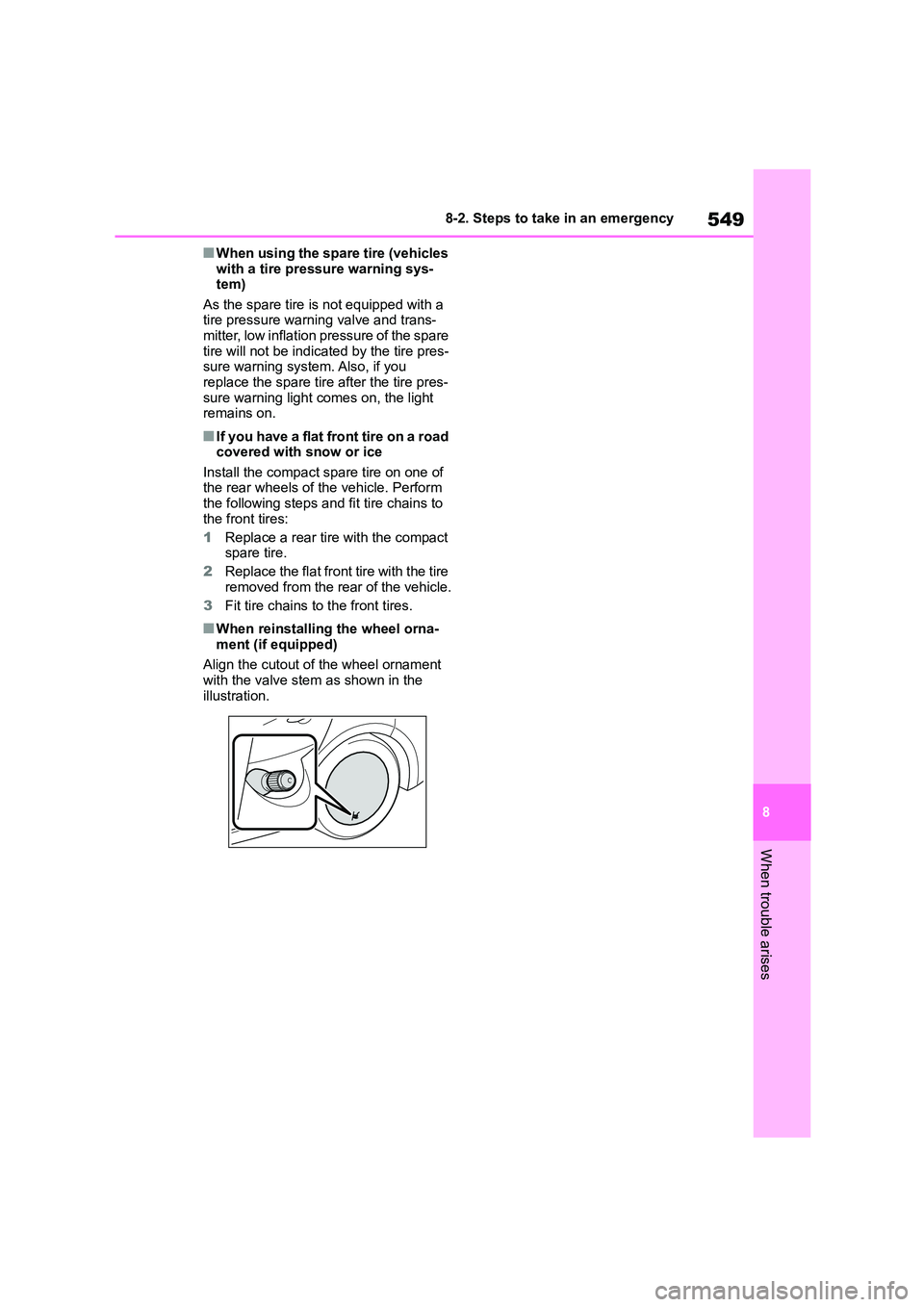
549
8
8-2. Steps to take in an emergency
When trouble arises
■When using the spare tire (vehicles
with a tire pressure warning sys- tem)
As the spare tire is not equipped with a
tire pressure warning valve and trans- mitter, low inflation pressure of the spare
tire will not be indicated by the tire pres-
sure warning system. Also, if you replace the spare tire after the tire pres-
sure warning light comes on, the light
remains on.
■If you have a flat front tire on a road covered with snow or ice
Install the compact spare tire on one of
the rear wheels of the vehicle. Perform the following steps and fit tire chains to
the front tires:
1 Replace a rear tire with the compact
spare tire.
2 Replace the flat front tire with the tire removed from the rear of the vehicle.
3 Fit tire chains to the front tires.
■When reinstalling the wheel orna-
ment (if equipped)
Align the cutout of the wheel ornament with the valve stem as shown in the
illustration.
Page 552 of 758
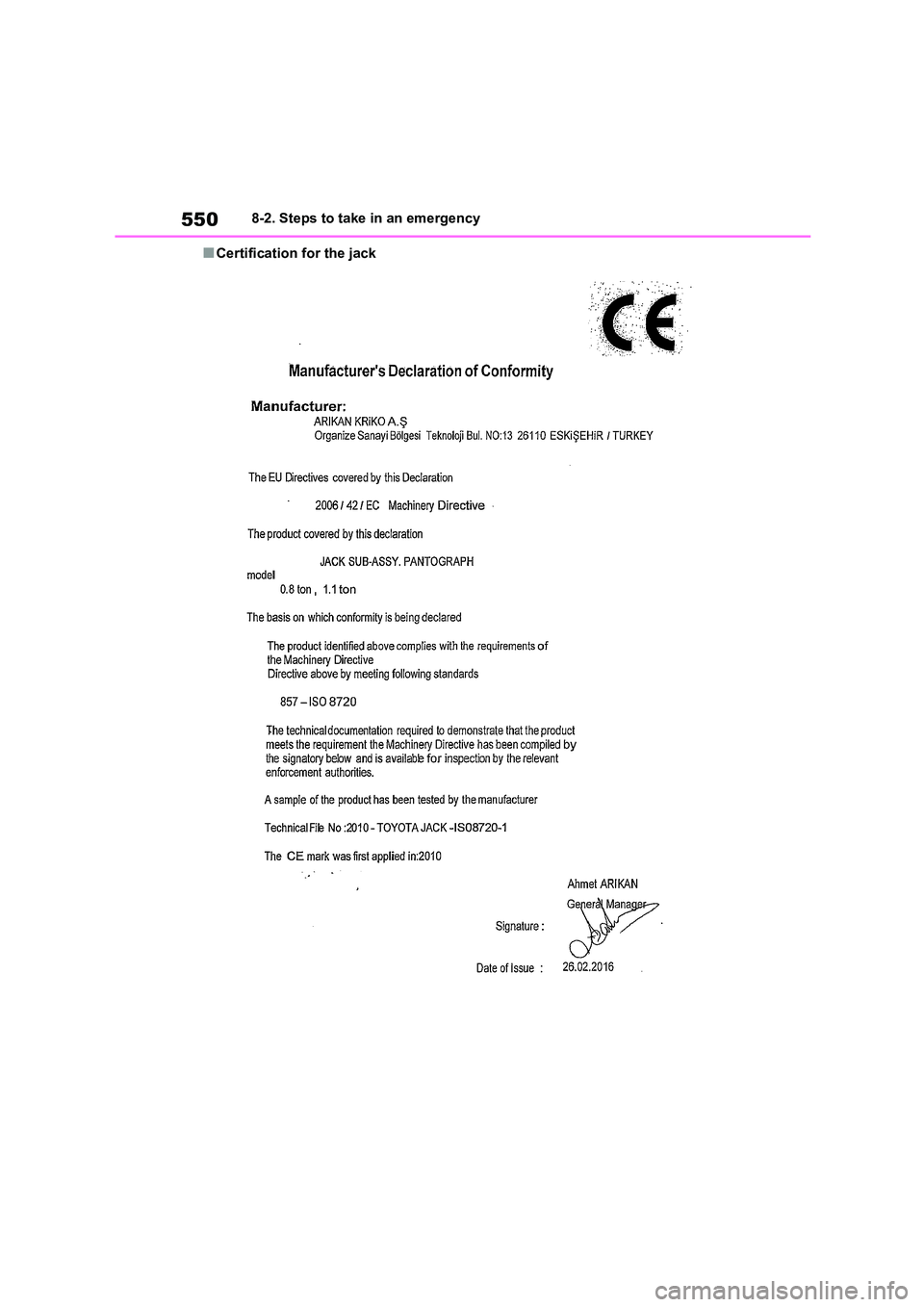
5508-2. Steps to take in an emergency
■Certification for the jack
Page 553 of 758
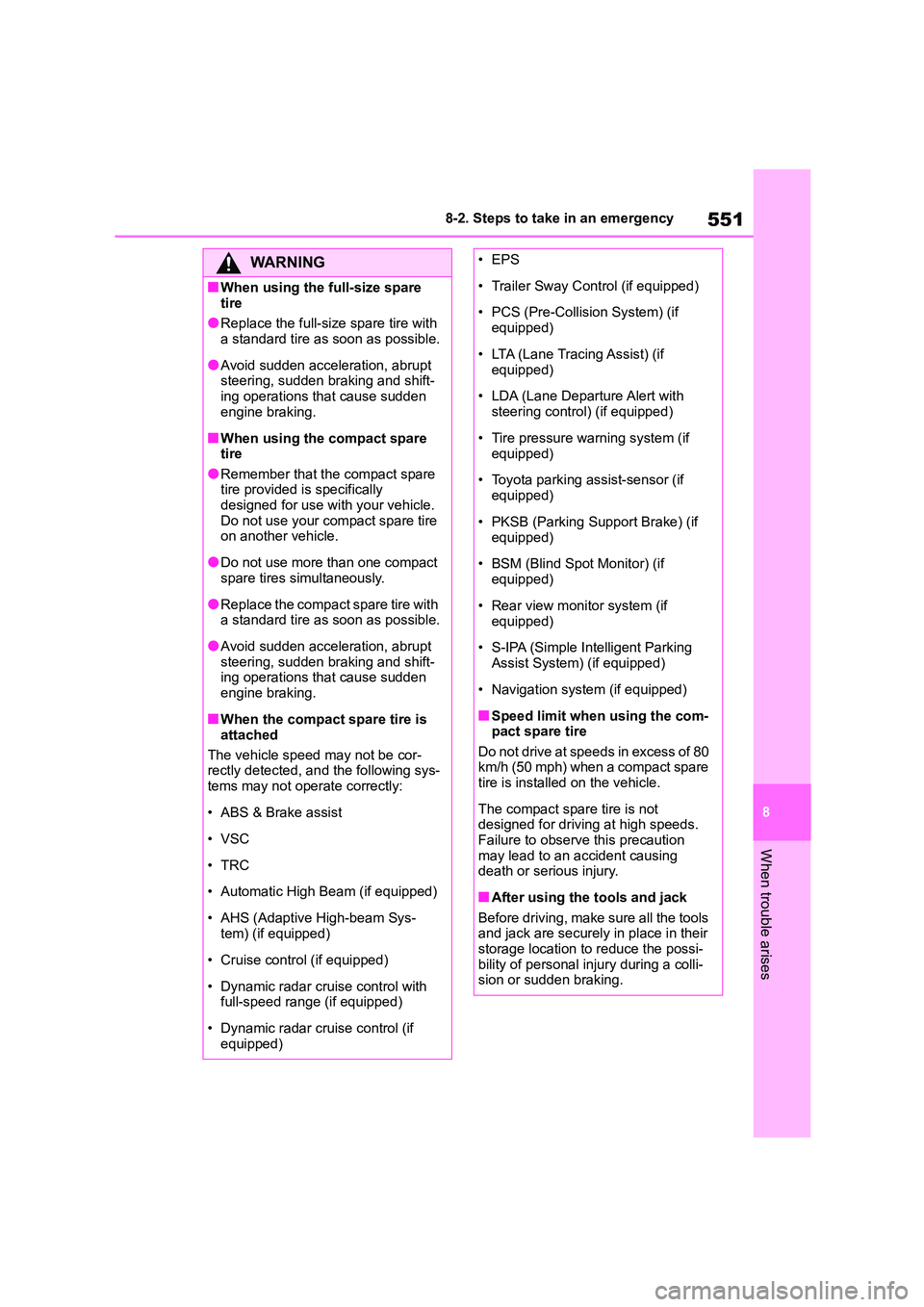
551
8
8-2. Steps to take in an emergency
When trouble arises
WA R N I N G
■When using the full-size spare
tire
●Replace the full-size spare tire with a standard tire as soon as possible.
●Avoid sudden acceleration, abrupt steering, sudden braking and shift-
ing operations that cause sudden
engine braking.
■When using the compact spare
tire
●Remember that the compact spare tire provided is specifically
designed for use with your vehicle.
Do not use your compact spare tire on another vehicle.
●Do not use more than one compact spare tires simultaneously.
●Replace the compact spare tire with a standard tire as soon as possible.
●Avoid sudden acceleration, abrupt steering, sudden braking and shift-
ing operations that cause sudden
engine braking.
■When the compact spare tire is
attached
The vehicle speed may not be cor-
rectly detected, an d the following sys-
tems may not operate correctly:
• ABS & Brake assist
• VSC
•TRC
• Automatic High Beam (if equipped)
• AHS (Adaptive High-beam Sys-
tem) (if equipped)
• Cruise control (if equipped)
• Dynamic radar cruise control with full-speed range (if equipped)
• Dynamic radar cruise control (if equipped)
• EPS
• Trailer Sway Control (if equipped)
• PCS (Pre-Collision System) (if
equipped)
• LTA (Lane Tracing Assist) (if
equipped)
• LDA (Lane Departure Alert with
steering control) (if equipped)
• Tire pressure warning system (if
equipped)
• Toyota parking assist-sensor (if
equipped)
• PKSB (Parking Support Brake) (if
equipped)
• BSM (Blind Spot Monitor) (if
equipped)
• Rear view monitor system (if
equipped)
• S-IPA (Simple Intelligent Parking
Assist System) (if equipped)
• Navigation system (if equipped)
■Speed limit when using the com- pact spare tire
Do not drive at speeds in excess of 80
km/h (50 mph) when a compact spare tire is installed on the vehicle.
The compact spare tire is not designed for driving at high speeds.
Failure to observe this precaution
may lead to an accident causing death or serious injury.
■After using the tools and jack
Before driving, make sure all the tools and jack are securely in place in their
storage location to reduce the possi-
bility of personal injury during a colli- sion or sudden braking.
Page 554 of 758
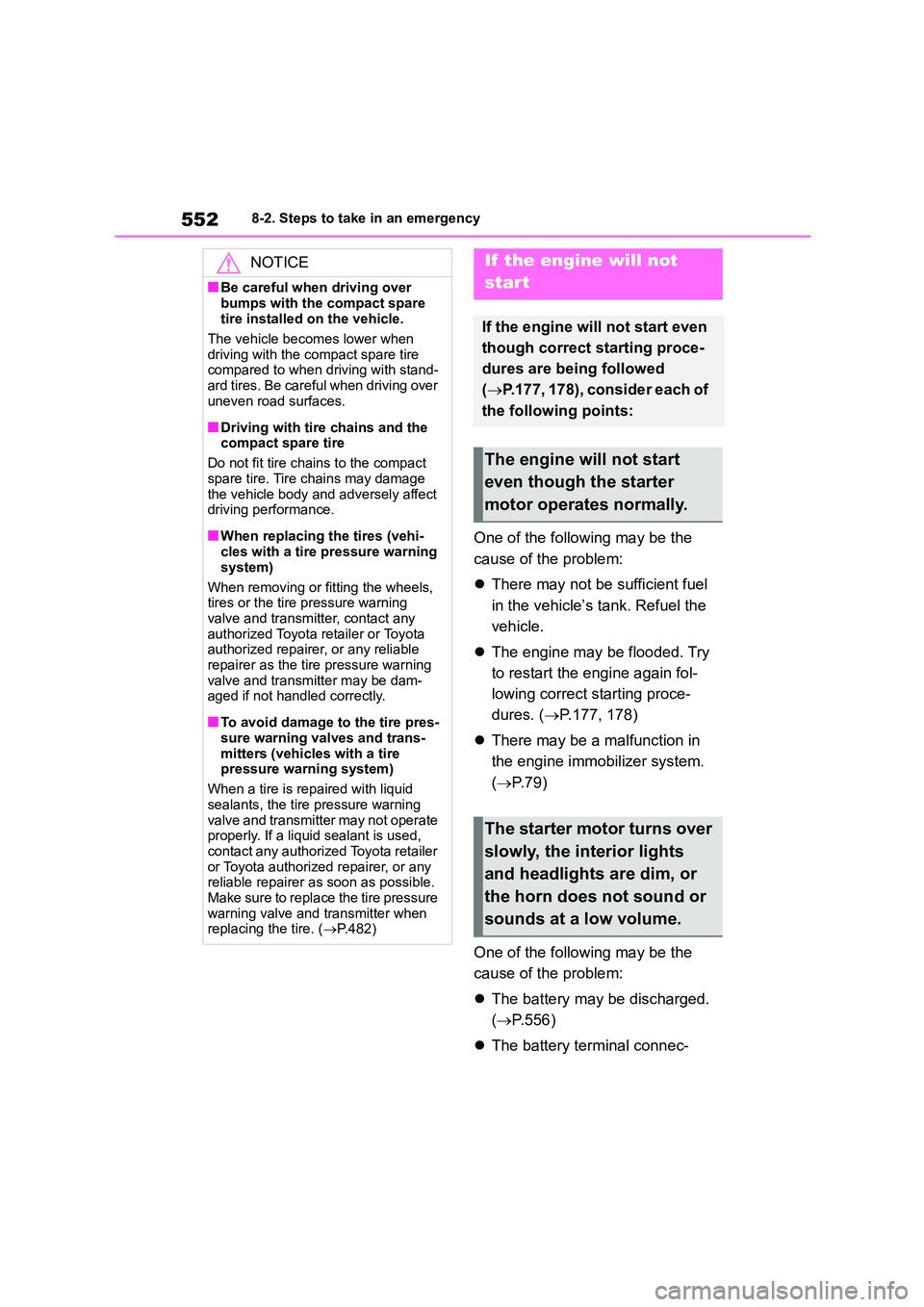
5528-2. Steps to take in an emergency
One of the following may be the
cause of the problem:
There may not be sufficient fuel
in the vehicle’s tank. Refuel the
vehicle.
The engine may be flooded. Try
to restart the engine again fol-
lowing correct starting proce-
dures. ( P.177, 178)
There may be a malfunction in
the engine immobilizer system.
( P. 7 9 )
One of the following may be the
cause of the problem:
The battery may be discharged.
( P.556)
The battery terminal connec-
NOTICE
■Be careful when driving over
bumps with the compact spare
tire installed on the vehicle.
The vehicle becomes lower when
driving with the compact spare tire
compared to when driving with stand- ard tires. Be careful when driving over
uneven road surfaces.
■Driving with tire chains and the compact spare tire
Do not fit tire chains to the compact
spare tire. Tire chains may damage the vehicle body and adversely affect
driving performance.
■When replacing the tires (vehi-
cles with a tire pressure warning
system)
When removing or fitting the wheels,
tires or the tire pressure warning
valve and transmitter, contact any authorized Toyota retailer or Toyota
authorized repairer, or any reliable
repairer as the tire pressure warning valve and transmitter may be dam-
aged if not handled correctly.
■To avoid damage to the tire pres-
sure warning valves and trans-
mitters (vehicle s with a tire pressure warning system)
When a tire is repaired with liquid
sealants, the tire pressure warning valve and transmitter may not operate
properly. If a liquid sealant is used,
contact any authorized Toyota retailer or Toyota authorized repairer, or any
reliable repairer as soon as possible.
Make sure to replace the tire pressure warning valve and transmitter when
replacing the tire. ( P.482)
If the engine will not
star t
If the engine will not start even
though correct starting proce-
dures are being followed
( P.177, 178), consider each of
the following points:
The engine will not start
even though the starter
motor operates normally.
The starter motor turns over
slowly, the interior lights
and headlights are dim, or
the horn does not sound or
sounds at a low volume.
Page 555 of 758
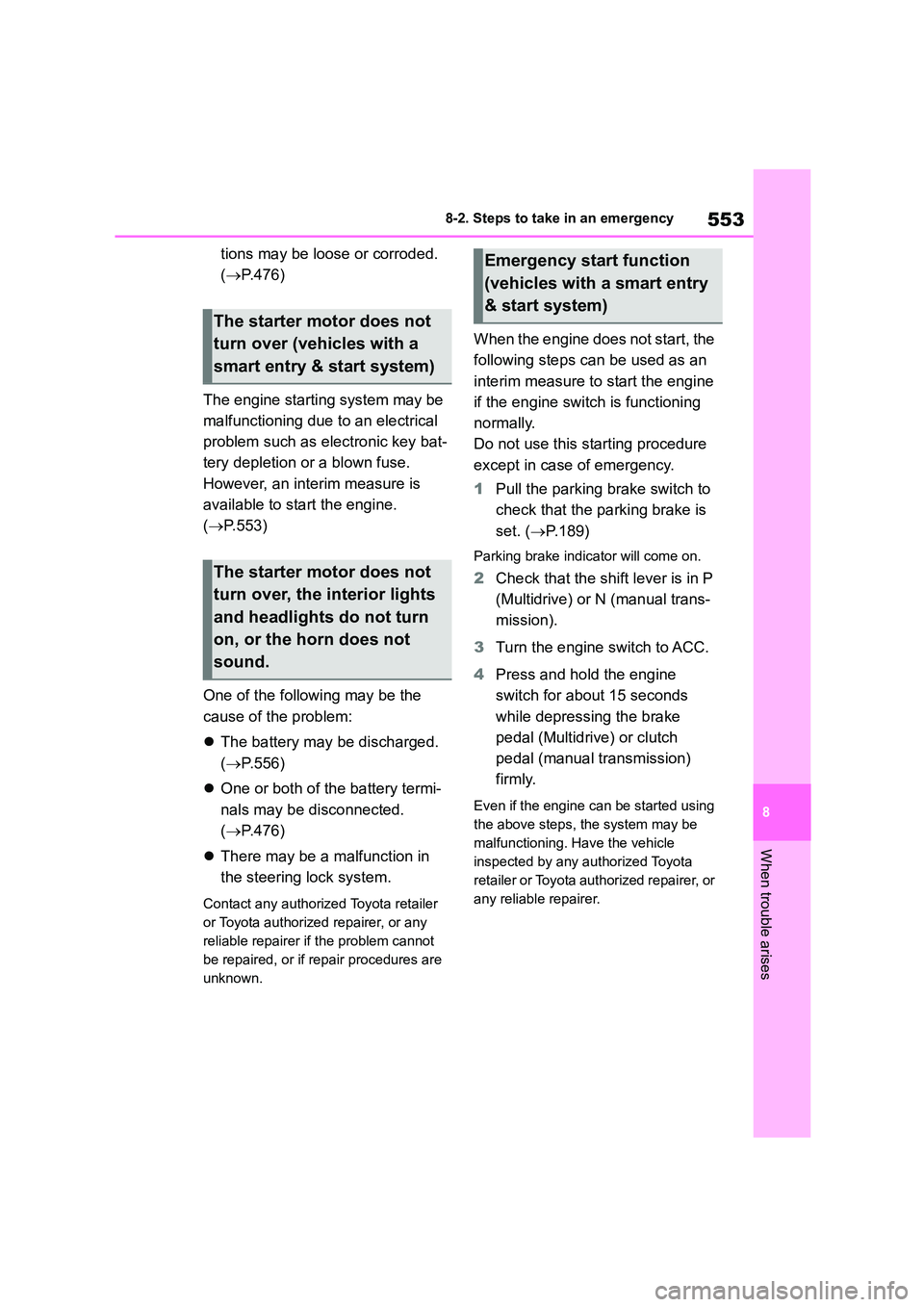
553
8
8-2. Steps to take in an emergency
When trouble arises
tions may be loose or corroded.
( P.476)
The engine starting system may be
malfunctioning due to an electrical
problem such as electronic key bat-
tery depletion or a blown fuse.
However, an interim measure is
available to start the engine.
( P.553)
One of the following may be the
cause of the problem:
The battery may be discharged.
( P.556)
One or both of the battery termi-
nals may be disconnected.
( P.476)
There may be a malfunction in
the steering lock system.
Contact any authorized Toyota retailer
or Toyota authorized repairer, or any
reliable repairer if the problem cannot
be repaired, or if repair procedures are
unknown.
When the engine does not start, the
following steps can be used as an
interim measure to start the engine
if the engine switch is functioning
normally.
Do not use this starting procedure
except in case of emergency.
1 Pull the parking brake switch to
check that the parking brake is
set. ( P.189)
Parking brake indicator will come on.
2Check that the shift lever is in P
(Multidrive) or N (manual trans-
mission).
3 Turn the engine switch to ACC.
4 Press and hold the engine
switch for about 15 seconds
while depressing the brake
pedal (Multidrive) or clutch
pedal (manual transmission)
firmly.
Even if the engine can be started using
the above steps, the system may be
malfunctioning. Have the vehicle
inspected by any authorized Toyota
retailer or Toyota authorized repairer, or
any reliable repairer.
The starter motor does not
turn over (vehicles with a
smart entry & start system)
The starter motor does not
turn over, the interior lights
and headlights do not turn
on, or the horn does not
sound.
Emergency start function
(vehicles with a smart entry
& start system)
Page 556 of 758
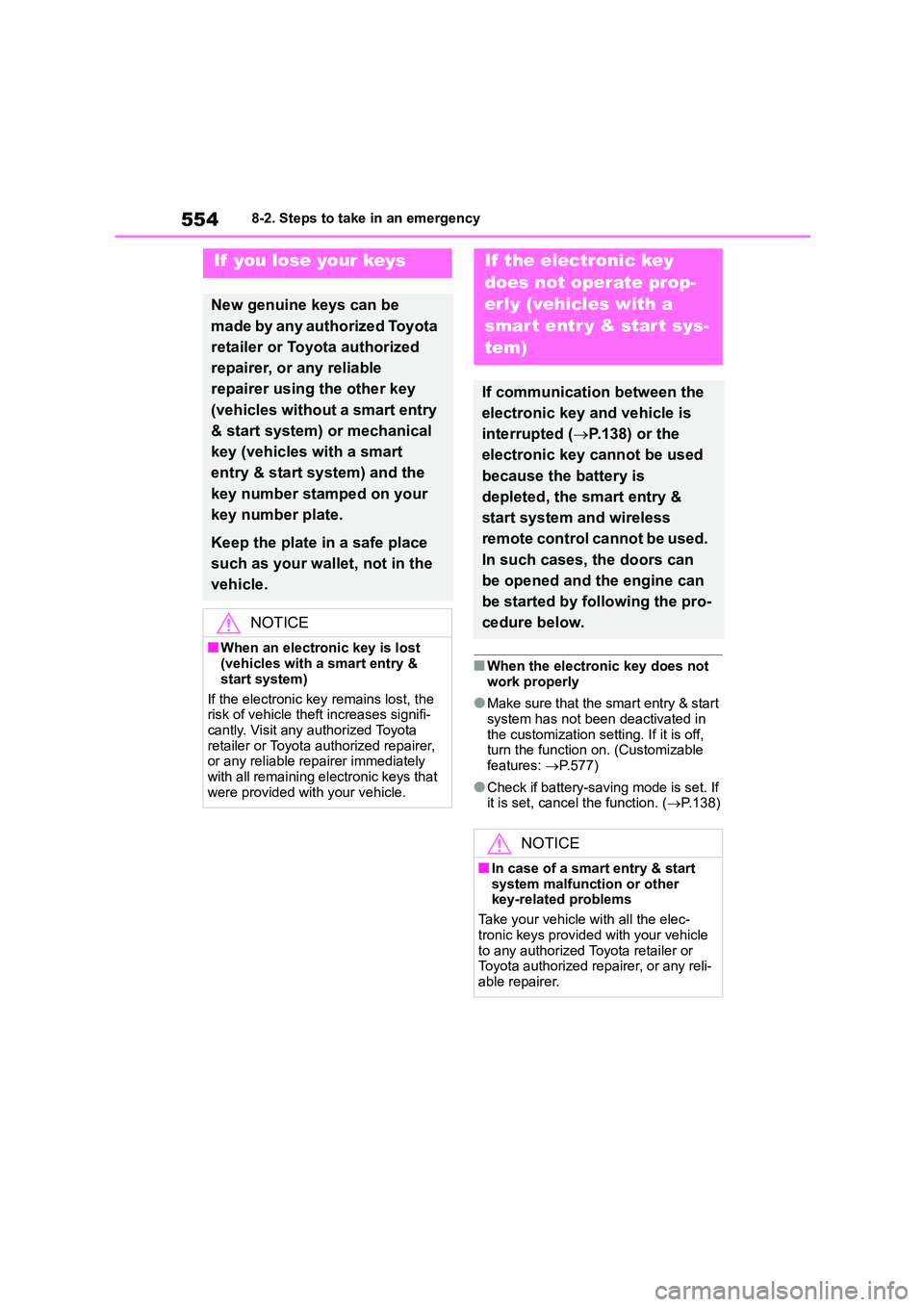
5548-2. Steps to take in an emergency
■When the electronic key does not
work properly
●Make sure that the smart entry & start
system has not been deactivated in
the customization setting. If it is off, turn the function on. (Customizable
features: P.577)
●Check if battery-saving mode is set. If it is set, cancel the function. ( P.138)
If you lose your keys
New genuine keys can be
made by any authorized Toyota
retailer or Toyota authorized
repairer, or any reliable
repairer using the other key
(vehicles without a smart entry
& start system) or mechanical
key (vehicles with a smart
entry & start system) and the
key number stamped on your
key number plate.
Keep the plate in a safe place
such as your wallet, not in the
vehicle.
NOTICE
■When an electronic key is lost
(vehicles with a smart entry &
start system)
If the electronic ke y remains lost, the
risk of vehicle thef t increases signifi-
cantly. Visit any authorized Toyota retailer or Toyota authorized repairer,
or any reliable repairer immediately
with all remaining electronic keys that were provided with your vehicle.
If the electronic key
does not operate prop-
erly (vehicles with a
smar t entr y & star t sys-
tem)
If communication between the
electronic key and vehicle is
interrupted ( P.138) or the
electronic key cannot be used
because the battery is
depleted, the smart entry &
start system and wireless
remote control cannot be used.
In such cases, the doors can
be opened and the engine can
be started by following the pro-
cedure below.
NOTICE
■In case of a smart entry & start
system malfunction or other key-related problems
Take your vehicle with all the elec-
tronic keys provided with your vehicle to any authorized Toyota retailer or
Toyota authorized repairer, or any reli-
able repairer.
Page 557 of 758
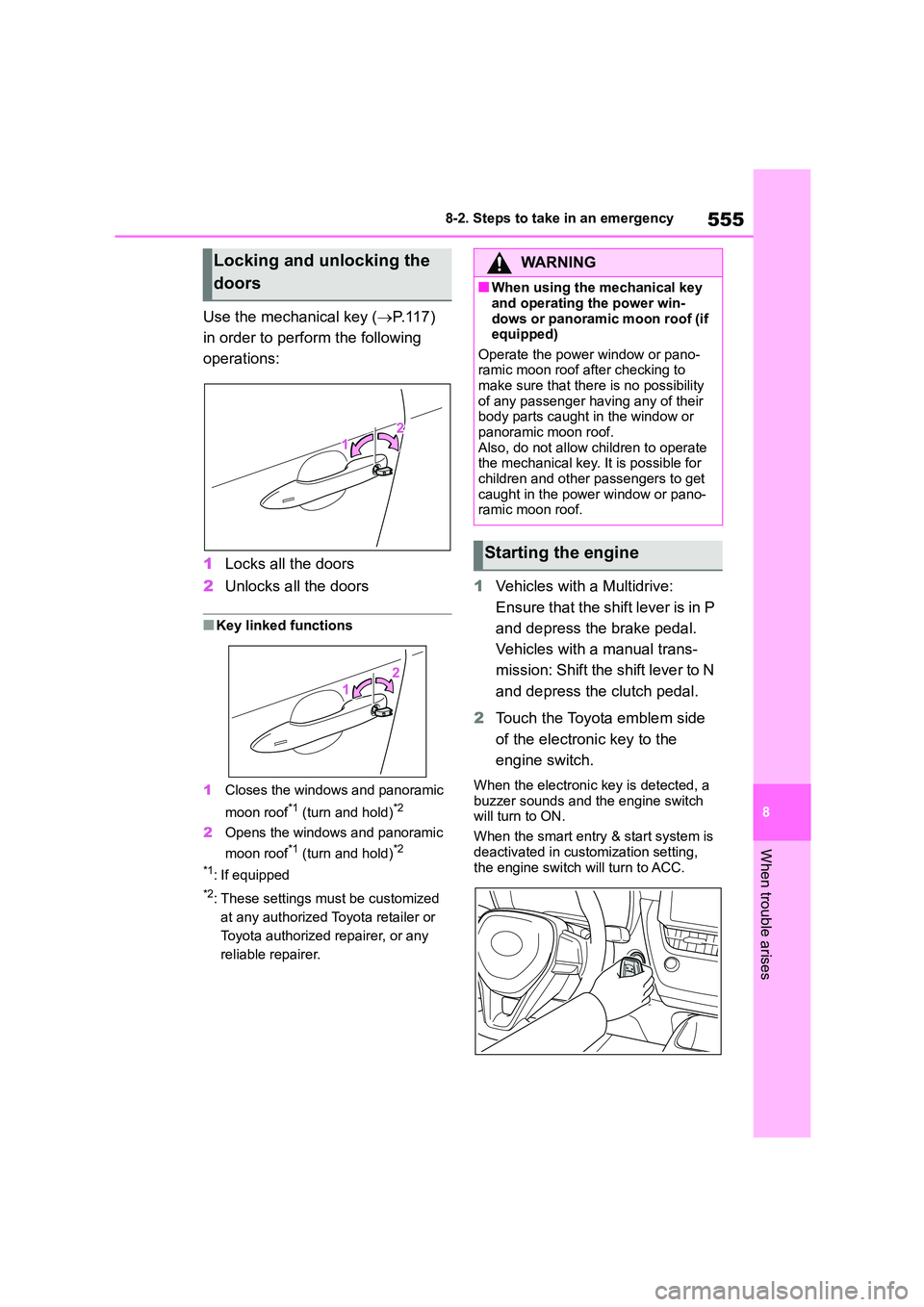
555
8
8-2. Steps to take in an emergency
When trouble arises
Use the mechanical key ( P.117)
in order to perform the following
operations:
1 Locks all the doors
2 Unlocks all the doors
■Key linked functions
1 Closes the windows and panoramic
moon roof*1 (turn and hold)*2
2 Opens the windows and panoramic
moon roof*1 (turn and hold)*2
*1: If equipped
*2: These settings must be customized
at any authorized Toyota retailer or
Toyota authorized repairer, or any
reliable repairer.
1 Vehicles with a Multidrive:
Ensure that the shift lever is in P
and depress the brake pedal.
Vehicles with a manual trans-
mission: Shift the shift lever to N
and depress the clutch pedal.
2 Touch the Toyota emblem side
of the electronic key to the
engine switch.
When the electronic key is detected, a
buzzer sounds and the engine switch
will turn to ON.
When the smart entry & start system is
deactivated in customization setting,
the engine switch will turn to ACC.
Locking and unlocking the
doors
WA R N I N G
■When using the mechanical key
and operating the power win-
dows or panoramic moon roof (if equipped)
Operate the power window or pano-
ramic moon roof after checking to make sure that there is no possibility
of any passenger having any of their
body parts caught in the window or
panoramic moon roof. Also, do not allow children to operate
the mechanical key. It is possible for
children and other passengers to get caught in the power window or pano-
ramic moon roof.
Starting the engine
Page 558 of 758
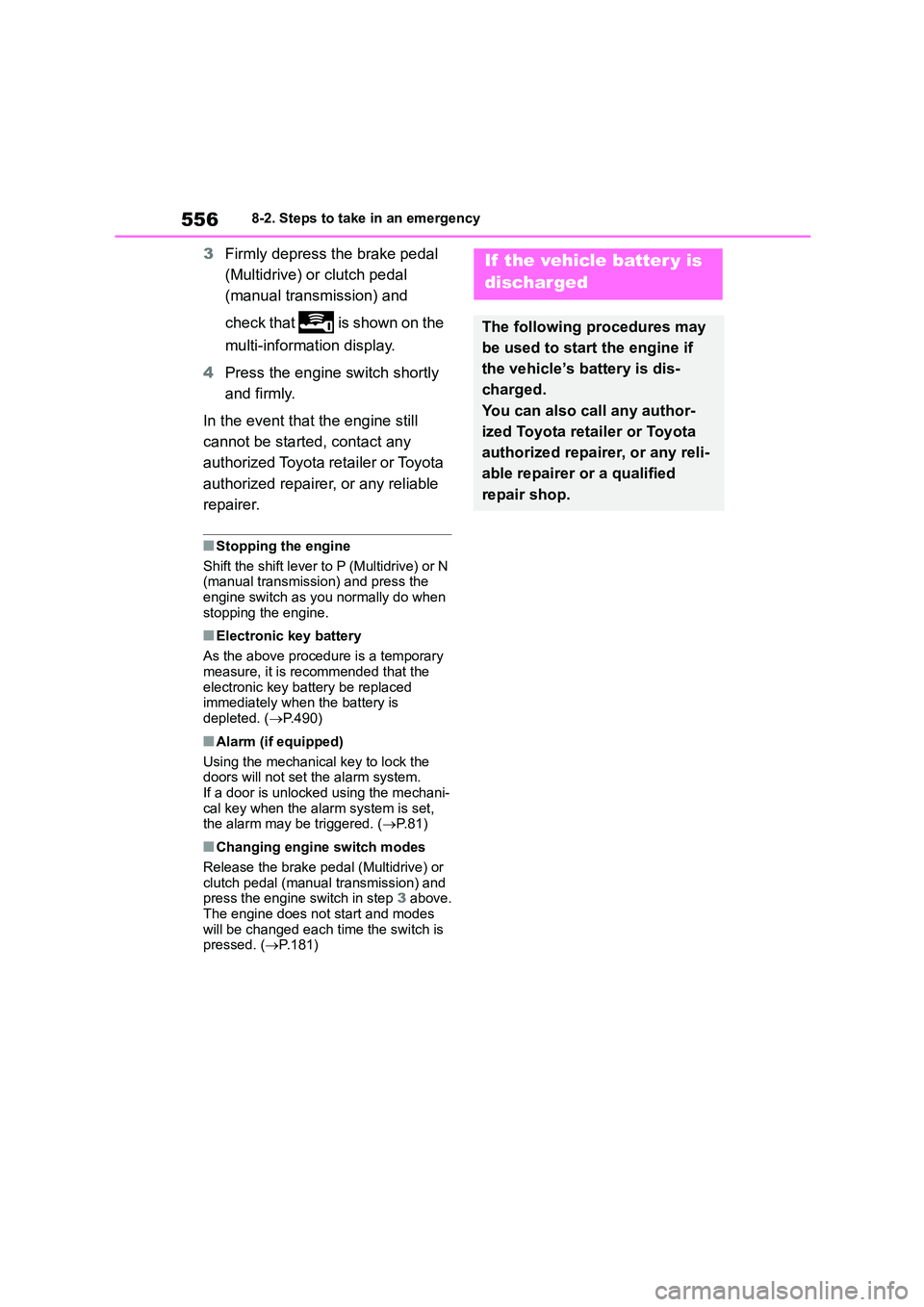
5568-2. Steps to take in an emergency
3Firmly depress the brake pedal
(Multidrive) or clutch pedal
(manual transmission) and
check that is shown on the
multi-information display.
4 Press the engine switch shortly
and firmly.
In the event that the engine still
cannot be started, contact any
authorized Toyota retailer or Toyota
authorized repairer, or any reliable
repairer.
■Stopping the engine
Shift the shift lever to P (Multidrive) or N
(manual transmission) and press the
engine switch as you normally do when stopping the engine.
■Electronic key battery
As the above procedure is a temporary
measure, it is recommended that the electronic key battery be replaced
immediately when the battery is
depleted. ( P.490)
■Alarm (if equipped)
Using the mechanical key to lock the doors will not set the alarm system.
If a door is unlocked using the mechani-
cal key when the alarm system is set, the alarm may be triggered. ( P.81)
■Changing engine switch modes
Release the brake pedal (Multidrive) or
clutch pedal (manual transmission) and press the engine switch in step 3 above.
The engine does not start and modes
will be changed each time the switch is pressed. ( P.181)
If the vehicle batter y is
discharged
The following procedures may
be used to start the engine if
the vehicle’s battery is dis-
charged.
You can also call any author-
ized Toyota retailer or Toyota
authorized repairer, or any reli-
able repairer or a qualified
repair shop.
Page 559 of 758
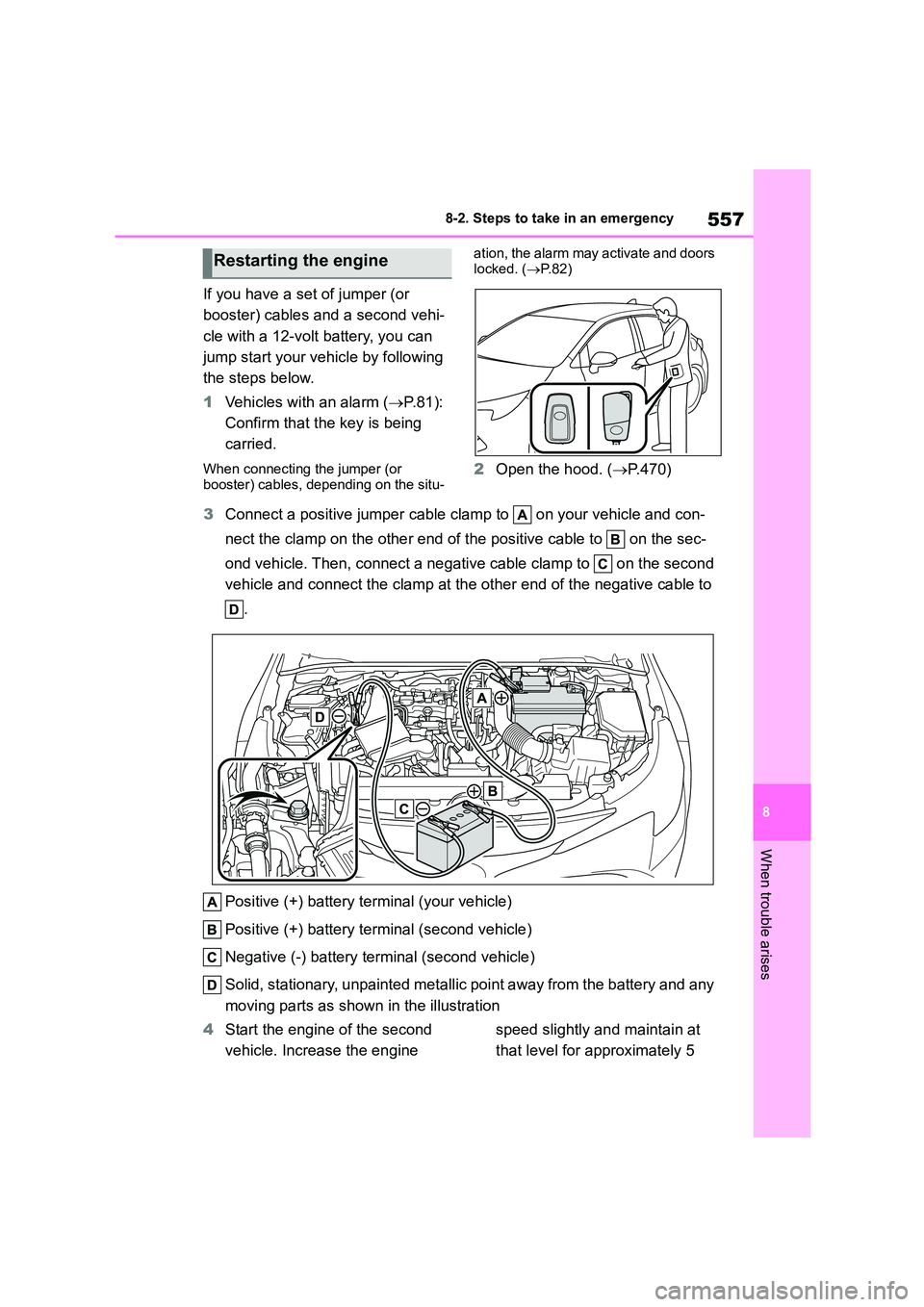
557
8
8-2. Steps to take in an emergency
When trouble arises
If you have a set of jumper (or
booster) cables and a second vehi-
cle with a 12-volt battery, you can
jump start your vehicle by following
the steps below.
1 Vehicles with an alarm (P. 8 1 ) :
Confirm that the key is being
carried.
When connecting the jumper (or booster) cables, depending on the situ-
ation, the alarm may activate and doors
locked. ( P. 8 2 )
2Open the hood. (P.470)
3 Connect a positive jumper cable clamp to on your vehicle and con-
nect the clamp on the other end of the positive cable to on the sec-
ond vehicle. Then, connect a negativ e cable clamp to on the second
vehicle and connect the clamp at the other end of the negative cable to
.
Positive (+) battery terminal (your vehicle)
Positive (+) battery terminal (second vehicle)
Negative (-) battery terminal (second vehicle)
Solid, stationary, unpainted metallic po int away from the battery and any
moving parts as shown in the illustration
4 Start the engine of the second
vehicle. Increase the engine
speed slightly and maintain at
that level for approximately 5
Restarting the engine
Page 560 of 758

5588-2. Steps to take in an emergency
minutes to recharge the battery
of your vehicle.
5 Vehicles with a smart entry &
start system: Open and close
any of the doors of your vehicle
with the engine switch OFF.
6 Maintain the engine speed of
the second vehicle and start the
engine of your vehicle by turning
the engine switch to ON.
7 Once the vehicle’s engine has
started, remove the jumper
cables in the exact reverse
order from which they were con-
nected.
Once the engine starts, have the
vehicle inspected at any author-
ized Toyota reta iler or Toyota
authorized repairer, or any reliable
repairer as soon as possible.
■Starting the engine when the bat- tery is discharged
The engine cannot be started by
push-starting.
■To prevent battery discharge
●Turn off the headlights and the audio
system while the engine is stopped.
(Vehicles with Stop & Start system: except when the engine is stopped by
the Stop & Start system.)
●Turn off any unnecessary electrical
components when the vehicle is run-
ning at a low speed for an extended period, such as in heavy traffic.
■When the battery is removed or dis-
charged
●Information stored in the ECU is
cleared. When the battery is depleted,
have the vehicle inspected at any authorized Toyota retailer or Toyota
authorized repairer, or any reliable
repairer.
●Some systems may require initializa-
tion. ( P.587)
■When removing the battery termi- nals
When the battery terminals are
removed, the information stored in the ECU is cleared. Before removing the
battery terminals, contact any author-
ized Toyota retailer or Toyota authorized repairer, or any reliable repairer.
■Charging the battery
The electricity stored in the battery will
discharge gradually even when the vehi- cle is not in use, due to natural dis-
charge and the draining effects of
certain electrical appliances. If the vehi- cle is left for a long time, the battery may
discharge, and the engine may be una-
ble to start. (The battery recharges auto- matically during driving.)
■When recharging or replacing the
battery
●Vehicles with a smart entry & start
system: In some cases, it may not be
possible to unlock the doors using the smart entry & star t system when the
battery is discharged. Use the wire-
less remote control or the mechanical key to lock or unlock the doors.
●Vehicles with a smart entry & start system: The engine may not start on
the first attempt after the battery has
recharged but will start normally after the second attempt. This is not a mal-
function.
●Vehicles with a smart entry & start
system: The engine switch mode is
memorized by the vehicle. When the
battery is reconnected, the system will return to the mode it was in before the
battery was discharged. Before dis-
connecting the battery, turn the engine switch off.
If you are unsure what mode the
engine switch was in before the bat- tery discharged, be especially careful
when reconnecting the battery.